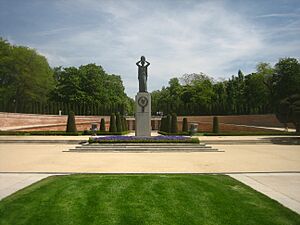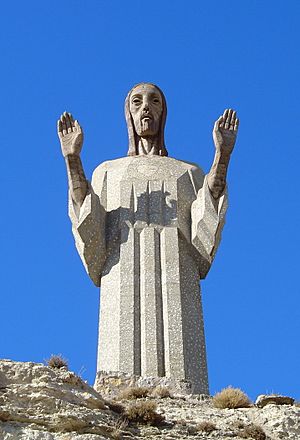Victorio Macho facts for kids
Quick facts for kids
Victorio Macho
|
|
|---|---|
 |
|
| Born | December 23, 1887 |
| Died | July 13, 1966 (aged 78) |
| Nationality | Spanish |
| Occupation | Architect |
| Buildings | Cristo del Otero |
Victorio Macho (born December 23, 1887, in Palencia, Spain – died July 13, 1966, in Toledo, Spain) was a very famous Spanish sculptor from the 20th century. Many people think he was one of the most important modern Spanish sculptors. His art style was a bit like art deco, which is a unique design style. After he passed away, his house and art studio in Toledo became a museum. It's called the Victorio Macho Museum, and it shows off all his amazing sculptures. He was even honored on a Spanish postage stamp!
Contents
Life of Victorio Macho
Victorio Macho was born in 1887 in Palencia, Spain. His family did not have much money. His parents sent him to the School of Fine Arts and Crafts in Santander. There, he started learning how to sculpt.
Early Studies and Fame
In 1903, when he was 16, Victorio moved to Madrid. He continued his art studies at the Academy of Fine Arts of San Fernando. He first became well-known for a sculpture of a famous writer, Benito Pérez Galdós. This sculpture was shown at the Museum of Modern Art in Madrid in 1921.
Time Away from Spain
Victorio Macho left Spain during a time when the country was ruled by a dictator named Miguel Primo de Rivera. He moved to Hendaye, a town in France, close to the Spanish border. While there, he created sculptures for other important Spanish thinkers like Miguel de Unamuno and Santiago Ramón y Cajal.
In 1936, he was chosen to be a member of the Academy of Fine Arts of San Fernando. But soon after, the Spanish Civil War started. Because of the war, he had to leave Spain again. He lived in France, Russia, and then in South America. He spent six months in Colombia and then lived for a long time in Lima, Peru. In Peru, he married Zoila Barrós Conti.
Return to Spain
Victorio Macho finally came back to Spain in 1952. He made his home and art studio in Toledo, a city in central Spain. After he died, his wife, Zoila, gave their house to the Spanish government. In 1967, this building became the Victorio Macho Museum. The house is known as the Tarpeian Rock.
In 1964, Victorio Macho received a very important award called the Grand Cross of the Order of Isabella the Catholic. This award is given for great achievements.
He passed away in Toledo on July 13, 1966. His body was brought back to Palencia, the city where he was born. He was buried at the base of his famous sculpture, the Cristo del Otero.
Famous Sculptures
Victorio Macho created many different types of sculptures. He made portraits of people, large public monuments, and religious art.

Portraits
Here are some of his well-known portrait sculptures:
- 1903 - Danielillo
- 1916 - Sailor Vasco (You can see this at the Victorio Macho Museum in Toledo.)
- 1920 - Recumbent statue of his brother Marcelo (Also at the Victorio Macho Museum in Toledo.)
- 1929 - Head of Ramón del Valle-Inclán (At the Victorio Macho Museum in Toledo.)
- 1935 - Bust of Pio Baroja (Located in San Sebastian, at the San Telmo Museum.)
- 1935 - Statue of mother (At the Victorio Macho Museum in Toledo.)
Public Works
Victorio Macho made many large sculptures for public places like parks and city squares.
- 1918 - Monument to Benito Pérez Galdós, in Retiro Park, Madrid.
- 1922 - Sculpture Monument to Juan Sebastián Elcano, in Guetaria, Spain.
- 1926 - Monument of Santiago Ramón y Cajal, in Retiro Park, Madrid.
- 1930 - Bust of Miguel de Unamuno, at the University of Salamanca.
- 1930 - The Roman statue on top of a building at Gran Via 60, Madrid.
- 1931 - Christ of Otero, a very large statue in Palencia, where he is buried.
- 1937 - Monument to Sebastian de Belalcazar, in Santiago de Cali, Colombia.
- 1945 - Monumento a Miguel Grau Seminario, in Lima, Peru.
- 1962 - Monument to Jacinto Benavente, in Retiro Park, Madrid.
- Alonso Berruguete Monument, in the Plaza Mayor of Palencia.
- Monument to Simón Bolívar Genius, in Plaza Caracas, Venezuela. Copies of this statue are also in Bogota (Colombia), Sao Paulo (Brazil), Riobamba (Ecuador), and Lima (Peru).
Religious Works
- Christ Church. This sculpture is in Corrales de Buelna, Cantabria.
Funeral Works
Victorio Macho also created sculptures for tombs and mausoleums.
- Dr. Llorente Sepulchre, at San Justo Cemetery, Madrid (1917).
- Grave of Marcelino Menéndez Pelayo, in Santander Cathedral.
- Grave Marcelo Macho, for his brother, at the Victorio Macho Museum in Toledo.
- Family Mausoleum Simón Bolívar, in the Trinity Chapel, Cathedral of Caracas, Venezuela (1930).
See also
 In Spanish: Victorio Macho para niños
In Spanish: Victorio Macho para niños


